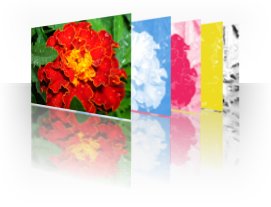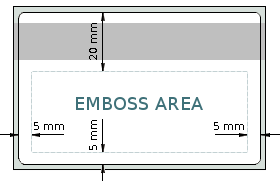Difference between revisions of "HOW TO PREPARE THE DESIGN"
| (3 intermediate revisions by the same user not shown) | |||
| Line 10: | Line 10: | ||
<li>'''Magnetic stripe.''' The magnetic stripe is 12,7 mm wide and is placed 4 mm off the card's edge. | <li>'''Magnetic stripe.''' The magnetic stripe is 12,7 mm wide and is placed 4 mm off the card's edge. | ||
</ul> | </ul> | ||
| − | <br>[[ | + | <br>[[File:card_margins.gif]]<br> |
| Line 18: | Line 18: | ||
<li>'''Scale.''' Always design your card in scale (1:1) | <li>'''Scale.''' Always design your card in scale (1:1) | ||
<li>'''Vector graphics.''' If possible use vector instead of raster images. This is important especially for text and logotypes (registered company logos). Always convert fonts in to curves. | <li>'''Vector graphics.''' If possible use vector instead of raster images. This is important especially for text and logotypes (registered company logos). Always convert fonts in to curves. | ||
| + | <br> | ||
| + | [[File:Raster_a.gif]]<br> | ||
<li>'''Raster images. Resolution''' There is a myth saying "If the resolution is high the quality of the image will be high also", that's not always true. The quality depends on many characteristics such as brightness, contrast, color dynamic, color balance, type of used media and many others. The optimal resolution for us using dry offset printing on PVC is 400dpi for CMYK images and 800-1200 dpi for monochrome images. | <li>'''Raster images. Resolution''' There is a myth saying "If the resolution is high the quality of the image will be high also", that's not always true. The quality depends on many characteristics such as brightness, contrast, color dynamic, color balance, type of used media and many others. The optimal resolution for us using dry offset printing on PVC is 400dpi for CMYK images and 800-1200 dpi for monochrome images. | ||
</ul> | </ul> | ||
| Line 26: | Line 28: | ||
| − | '''COLOR MODELS. COLORS'''<br> | + | '''COLOR MODELS. COLORS'''<br><br> |
| + | [[File:cmyk.jpg]]<br> | ||
'''Color model.''' The card design must be made using CMYK colors. Files containing RGB colors will be send back to the client for remaking. In case of using '''additional colors''', they need to be added as spot colors using the '''PANTONE Coated!''' (Pantone C) scale. Colors set using RAL, HKS, PANTONE Uncoated and other color models are NOT applicable. We cannot accept such files, the client has to remake them. | '''Color model.''' The card design must be made using CMYK colors. Files containing RGB colors will be send back to the client for remaking. In case of using '''additional colors''', they need to be added as spot colors using the '''PANTONE Coated!''' (Pantone C) scale. Colors set using RAL, HKS, PANTONE Uncoated and other color models are NOT applicable. We cannot accept such files, the client has to remake them. | ||
| Line 42: | Line 45: | ||
<li> The maximum number of symbols on a row (including blank spaces) is : 28 for low letters, 20 for capitals. | <li> The maximum number of symbols on a row (including blank spaces) is : 28 for low letters, 20 for capitals. | ||
<li> The minimum space between rows is 2 mm. | <li> The minimum space between rows is 2 mm. | ||
| − | <li> The colors for emboss printing can be : silver, gold, black or white. | + | <li> The colors for emboss printing can be : silver, gold, black or white.<br> |
| + | [[File:Card_emb_margins_en.gif]]<br> | ||
</ul> | </ul> | ||
'''Personalization with thermal print.'''<br> | '''Personalization with thermal print.'''<br> | ||
Latest revision as of 06:10, 1 July 2015
The manufacturing of plastic cards is cooperative process, in which your files preparation is of great significance. Before you start designing your cards, please get familiar with the specifications described below. Knowing the specifications will save a lot of time in communication and file transfer.
Contents
CARD'S ATTRIBUTES
- Card's dimensions. After cutting the size is 85,7 x 53,9 mm and the corner roundness is 3 mm.
- Print area. The files print area must be 2 mm larger from each side (89,7 x 57,9 mm).
- Magnetic stripe. The magnetic stripe is 12,7 mm wide and is placed 4 mm off the card's edge.
CARD DESIGN
- Scale. Always design your card in scale (1:1)
- Vector graphics. If possible use vector instead of raster images. This is important especially for text and logotypes (registered company logos). Always convert fonts in to curves.

- Raster images. Resolution There is a myth saying "If the resolution is high the quality of the image will be high also", that's not always true. The quality depends on many characteristics such as brightness, contrast, color dynamic, color balance, type of used media and many others. The optimal resolution for us using dry offset printing on PVC is 400dpi for CMYK images and 800-1200 dpi for monochrome images.
- DO NOT IMPORT lower than the recommended resolution.
- DO NOT CREATE files larger than needed. It is a waste of yours and ours time.
COLOR MODELS. COLORS

Color model. The card design must be made using CMYK colors. Files containing RGB colors will be send back to the client for remaking. In case of using additional colors, they need to be added as spot colors using the PANTONE Coated! (Pantone C) scale. Colors set using RAL, HKS, PANTONE Uncoated and other color models are NOT applicable. We cannot accept such files, the client has to remake them.
- Colors set by using Pantone which will be printed with process inks will be transformed to PANTONE color bridge CMYK EC !!!
PERSONALISATION
Personalizing with embossed letters (embossing).
Requirements for emboss printing:
- The field for embossing must be 5 mm off the left, right or lower edge of the card and 20 mm off the upper edge.
- The font for embossing is fixed and cannot be changed. Among the popular true-type fonts OCR is the closest to the one used standard embossing equipment.
- The letters can be capital only and one size only - 3 mm for letters, and 3 or 5 mm for digits.
- The maximum number of symbols on a row (including blank spaces) is : 28 for low letters, 20 for capitals.
- The minimum space between rows is 2 mm.
- The colors for emboss printing can be : silver, gold, black or white.

Personalization with thermal print.
There are no restrictions on the fonts used when personalizing with thermal print except for the size of the font - it must be at least 4 pt. If you are using non standard font you must attach the font file to the other files.
Magnetic stripe with data record.
Please take in mind the following when the card should have a magnetic stripe:
- the size of the magnetic stripe (you cannot print over it) is 85,7 mm / 12,7 mm.
- the magnetic stripe has strictly fixed place: 4 mm off the upper or lower edge lengthwise. If there is emboss on the card it must NOT be over the magnetic stripe.
- the magnetic stripe has 3 tracks for encoding data (ISO 4909) - it is necessary to provide us with the information you want to be written to the tracks.
- the magnetic stripe can be LoCo-brown, LoCo-black, HiCo-black, HiCo-gold and HiCo-silver.
PERFORATION AND PUNCHING
- Perforation
Perforation is the process of creating openings on the card with specific size and position, as shown on the picture on the right. If necessary all of the openings shown can be made or any combination of them.- A - elongated opening on the short side of the card -
- B - elongated opening on the long side of the card -
- C - round opening on the short side of the card -
- D - round opening in the corner of the card -
- E - round opening on the long side of the card -
There is a option for creating openings on a postions different from the shown, specified by the client.
(The postion and the size of non standart perforation is specified in addition)
It must be noted that cards with contactless chip can be perforated only in specific positions so that the antena wich is needed for the functioning of the chip will not be cut. The position depends from the chip type, for more information about preforation of contactless cards consult with us. - Punching
Mini Visa
The new mini card is actually a part of a standard ISO CR-90 card with thickness of 0,76mm. It can have magnetic stripe if desired. The mini card works with all kind of devices for reading and writing except the ATMs, it cannot be used with ATM. The opening in one of the corners allows the card to be hanged or attached to key chains, mobile phones. The mini cards are extremely suitable as promo cards, loyal customer cards, mini calendars, certificate of origin etc.
Three Key Tag
Three Key Tag is a standart ISO CR-90 card with thickness of 0,76mm devided in to three smaller cards with option for an opening in one of the corners. The card can not have contactless chip or magnetic stripe. The card thikness as the Mini Visa can not be different from 0,76mm. The Three Key Tag cards are suitable for different types of promotions and discounts, where more than one person can use the same service.
SOFTWARE PRODUCTS AND FILE FORMATS (EXTENTIONS)
The card design described so far can be created using software products listed below:
- Adobe Illustrator CS5.5 - » download
Template for creating card design using Adobe Illustrator CS5.5 This is the preferred format for us. All fonts must be converted to curves. All images must be included in the file, NOT linked from outer file(s). All effects and transparencies must be simplified with EXPAND APPEARANCE and FLATTEN TRANSPARENCY. - Adobe PhotoShop CS5.5 - » download
Template for creating card design using Adobe Photoshop CS5.5 The files can be saved as TIFF or PSD format. Raster the containing text layers. When you open the template, please do not change the color profile embedded in the file - choose "Don't color manage". - Corel Draw 15(X5) - » download
Template for creating card design using CorelDraw 15(X5) All fonts must be converted to curves. The file must NOT contain web effects such as LENS, TRANSPERANCY, DROP SHADOW and POWERCLIP for raster or vector images and transparent raster images in its final version. All Mesh-objects and gradations must be rasterized. If the design was first made using CorelDraw and then exported to EPS please check that the sent file does NOT contain segmented gradations or images.
IMPORTANT !!! The files will be send back to the client for remaking if contain any of the defects listed above!
IMPORTANT !!! Files created using Microsoft Word, Excel, PowerPoint or similar products are NOT acceptable!
